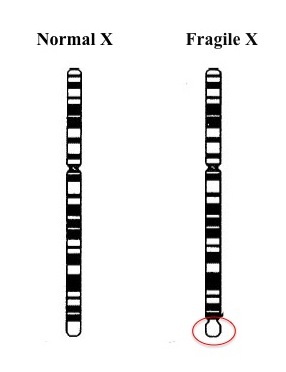One of the most common inherited causes of mental retardation (second after Down’s syndrome) and autism as well as being associated with attention deficit hyperactivity disorder, and that has an incidence of about 1 in 2000-4000 for males and 1 in 5000-8000 for females. The syndrome was first discovered in 1943 through the combined efforts of James Purdon Martin (1893-1984) and Julia Bell (1879-1979), being referred then as the Martin-Bell syndrome. On the basis of studying a family of 11 severely retarded males, they identified it as having an X-linked recessive genetic inheritance. The in 1969, Herbert Lubs noted a constriction at the end of the long (or q) arm of the X chromosome, giving the appearance of it being ‘broken’ and hence the adjective ‘fragile’ (see figure below). The cause of the syndrome itself is a defective gene called FRM-1 located on the long arm of the X chromosome, which was discovered in 1991 by an international team. It signs include anxiety and mood swings, epilepsy (in 25% of cases), hyperextensible joints (especially those of the fingers), and a number of stigmata (e.g., long face, large ears, flat feet). Mental disability is evident in about 80% of carrier male and 50% of carrier females.
